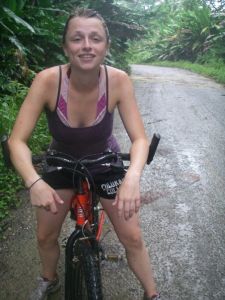 On rainy day in Bocas del Toro, my travel companion Lindsey and I played cards in our hostel (Mondu Taitu) and brainstormed activities that could be equally fun in sun as in the rain. After talking to David, one of the friendly American owners of Mondu Taitu, we decided a bike ride through the island to Playa del Drago on the opposite side was just the thing to do. David told us the bike ride was just as fun, if not more, in the rain and the drizzle would keep us from getting too hot. The journey was 15 km each way and hilly, but we were up for the challenge.
On rainy day in Bocas del Toro, my travel companion Lindsey and I played cards in our hostel (Mondu Taitu) and brainstormed activities that could be equally fun in sun as in the rain. After talking to David, one of the friendly American owners of Mondu Taitu, we decided a bike ride through the island to Playa del Drago on the opposite side was just the thing to do. David told us the bike ride was just as fun, if not more, in the rain and the drizzle would keep us from getting too hot. The journey was 15 km each way and hilly, but we were up for the challenge.
We found bikes to rent in town for US$5 each, though I can’t say these bikes were in top condition. Because of the humidity, ocean air and general lack of upkeep, most bike rental places have rather rusty and ill-working bikes. The brakes worked (mostly at least) and the tires were inflated though, so Linds and I set out on our journey.
 When my oldest childhood friend and I decided to go to Panama, we knew that we had to hike its tallest mountain. Being from Colorado, where 14,000 foot peaks seem to be everywhere, we felt pretty confident that we could conquer Panama’s highest mountain, which stands at just over 11,000 feet. However, as we set out in the dark on our trek up the volcano that early morning, we did not fully anticipate the difficulty of actually reaching the top and coming back down in one day.
When my oldest childhood friend and I decided to go to Panama, we knew that we had to hike its tallest mountain. Being from Colorado, where 14,000 foot peaks seem to be everywhere, we felt pretty confident that we could conquer Panama’s highest mountain, which stands at just over 11,000 feet. However, as we set out in the dark on our trek up the volcano that early morning, we did not fully anticipate the difficulty of actually reaching the top and coming back down in one day. 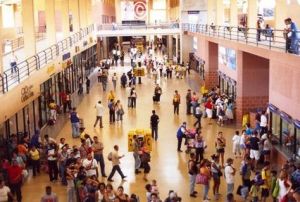 Albrook Bus Terminal
Albrook Bus Terminal The Argentine Tango is a social dance which originated in Argentina and was later adopted in Uruguay and the rest of the world. Many people confuse the Argentine Tango with Ballroom Tango.
The Argentine Tango is a social dance which originated in Argentina and was later adopted in Uruguay and the rest of the world. Many people confuse the Argentine Tango with Ballroom Tango.  Over the last decade or so, Honduras has been focusing its efforts one eco tourism. Maybe they are just jumping on the bandwagon that made Costa Rica so popular, or maybe they just trying to make a buck. Either way, a number of extremely beautiful preserves and parks have been popping up all over the country. One such park is the Rio Platano Biosphere Reserve.
Over the last decade or so, Honduras has been focusing its efforts one eco tourism. Maybe they are just jumping on the bandwagon that made Costa Rica so popular, or maybe they just trying to make a buck. Either way, a number of extremely beautiful preserves and parks have been popping up all over the country. One such park is the Rio Platano Biosphere Reserve.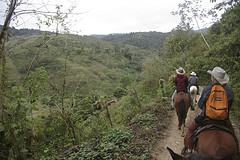 There are plenty of cheap places to stay in Honduras and just as many tours and activities to do. But, for less than the cost of mid-priced hotel, you can get a truly amazing experience and the accommodations for it! A small farm by the name of Finca El Cisne offers a glimpse into life of a not so distant Honduras.
There are plenty of cheap places to stay in Honduras and just as many tours and activities to do. But, for less than the cost of mid-priced hotel, you can get a truly amazing experience and the accommodations for it! A small farm by the name of Finca El Cisne offers a glimpse into life of a not so distant Honduras.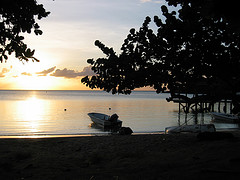 Taxis very all over the country very in shape, style, and sheer number depending on where you are. In the Bay Islands for example, you wont find taxis on every island, only the big ones. Rotan, of course being the only big one. Places like Guanaja on the other hand, don’t have many cars, let alone a taxi system. Below are some tips for catching a taxi on the island of Rotan.
Taxis very all over the country very in shape, style, and sheer number depending on where you are. In the Bay Islands for example, you wont find taxis on every island, only the big ones. Rotan, of course being the only big one. Places like Guanaja on the other hand, don’t have many cars, let alone a taxi system. Below are some tips for catching a taxi on the island of Rotan.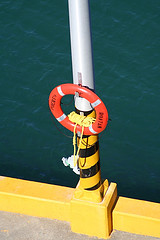 In the grand scheme of things, Honduras it still very young when it comes to tourisim. As such, the country has done little to enforce safety in most of the major tourist areas. This point is not meant to scare you away from visiting Honduras, but more to make sure you are aware of the dangers so that you can protect your self from them.
In the grand scheme of things, Honduras it still very young when it comes to tourisim. As such, the country has done little to enforce safety in most of the major tourist areas. This point is not meant to scare you away from visiting Honduras, but more to make sure you are aware of the dangers so that you can protect your self from them.  While each country in Central America has its own take on food, there are a few staple items that you can find everywhere. If you have ever been anywhere in Central America, you knew right away what I was talking about, rice and beans. Rice and beans in Honduras? Go figure. Aside from this Central America staple items, there are a number of other popular dishes in the country.
While each country in Central America has its own take on food, there are a few staple items that you can find everywhere. If you have ever been anywhere in Central America, you knew right away what I was talking about, rice and beans. Rice and beans in Honduras? Go figure. Aside from this Central America staple items, there are a number of other popular dishes in the country.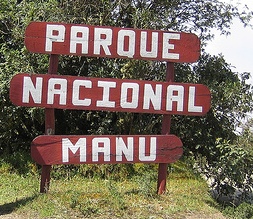 Manu National Park (Parque Nacional Manu) is the largest national park in Peru, covering an area of 15,328 sq km/ 5,918 sq miles. It has been designated as a UNESCO World Heritage Site and even today it’s fairly inaccessible by road.
Manu National Park (Parque Nacional Manu) is the largest national park in Peru, covering an area of 15,328 sq km/ 5,918 sq miles. It has been designated as a UNESCO World Heritage Site and even today it’s fairly inaccessible by road.